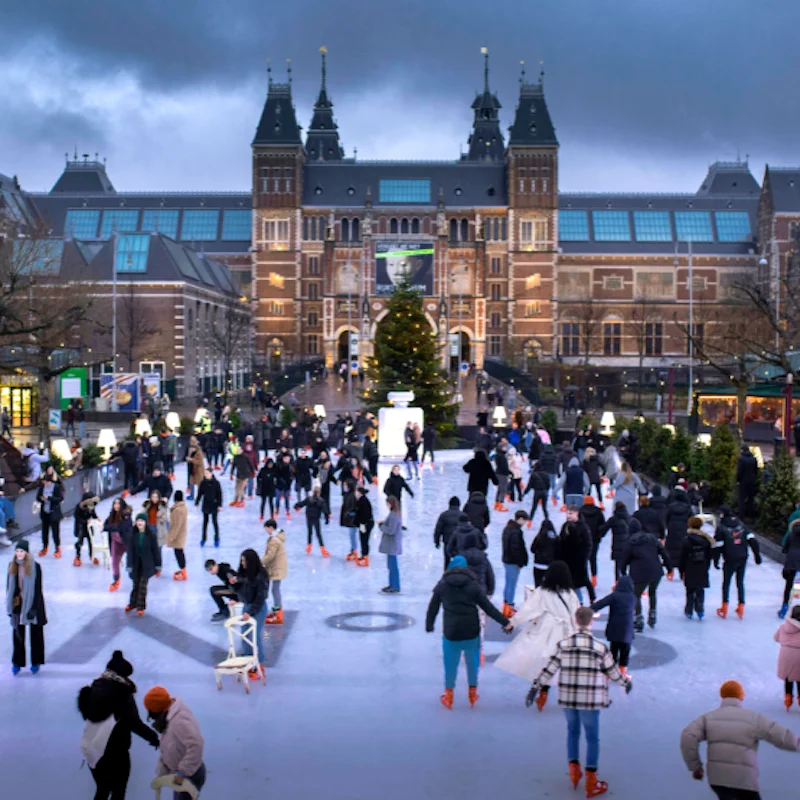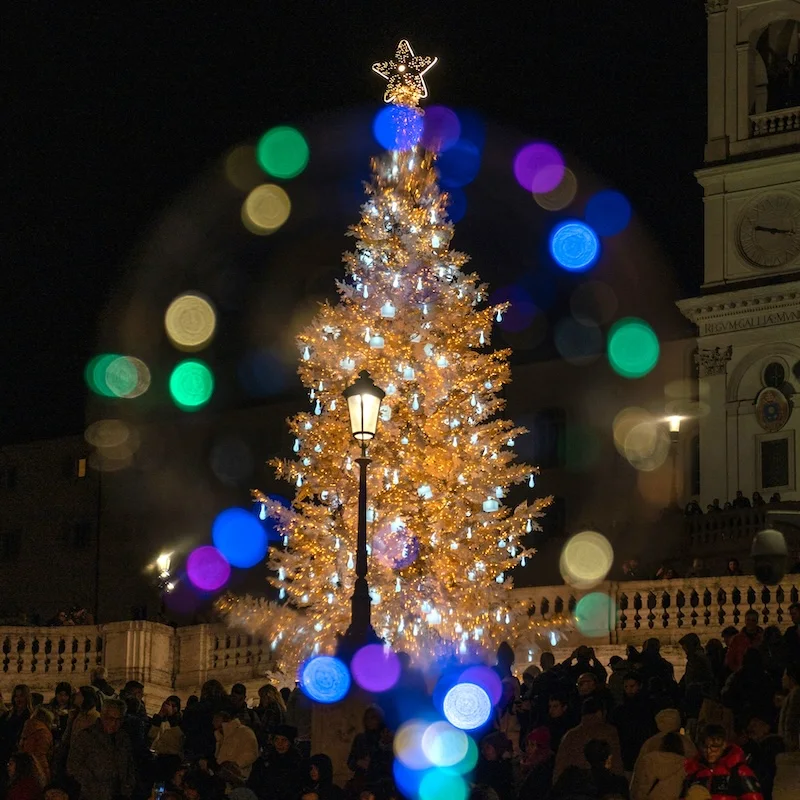Home > Travel Planning > Read This Before You Travel to Venice, Italy
Share this post
Venice, Italy is one of the most traveled to destinations in Europe. Its lagoon is a UNESCO World Heritage Site, and it's home to 118 islands connected by 438 bridges.
With narrow winding streets and canals that seem to snake through the old city, Venice is also Europe's largest car-free urban area.
To make the most of your trip to Venice, there are a few things that you should know about the city, like things to do, how to get there, how to get around the ancient city, and more.
As lovers of all-things-travel, we decided to write this guide to answer any questions that travelers might have about Venice in order to help make your trip the best it can possibly be.
How many days to spend in Venice
The common consensus among travelers seems to be anywhere from 2-5 days. How long you should stay there really depends on how you like to travel and how you want to pass the time during your trip.
The ancient city of Venice isn't large, it's only a couple of miles across. While many people can explore it all on foot in just a couple of days, you may want another day or two to have more opportunities to try new restaurants, pop into local shops, or take your time enjoying the atmosphere.
When to visit Venice
The summer months are, by far, the most popular months to visit Venice. After all, the kids are off from school, the weather is great, and the pace of life slows down a bit.
Because Venice is such a small city and there are so many people who want to see it, the summer months aren't really the best time to go. There will be a lot of crowds, and high demand creates limited availability, which means higher costs.
Fortunately, Venice has a very temperate climate with mild changes between seasons. It never really gets that cold or that hot, though rainfall is expected year-round to some degree.
While the summer months, particularly July, are the warmest with the least amount of rain, the "shoulder" months are very pleasant too and a great option if you're hoping to avoid the absolute busiest times.

The coldest months in Venice are January and February and the rainiest are September, October, and November.
While January and February are the coldest, they're also some of the least rainy months in the city and are when Venice's famous mask festival takes place. Still, cold is relative. January's average is 40 degrees °F (4.4 Celsius). During the mask festival, Venice sees a lot of tourism. If this is something that interests you, make sure you plan your trip in advance to get the best options and prices.
All in all, May is a very nice time to visit Venice. You get relatively good weather and fewer crowds than expected in the peak summer months.
Where to stay in Venice
If it's your first time in Venice, you should definitely stay in the ancient city.
This historic part of Venice is foot-traffic only and filled with narrow sidewalks and canals, winding around the ancient islands. People get around by boat (there are public and private transportation options like Vaporetto and Traghetti) or simply by walking.

This area has 7 distinct neighborhoods and each has something different to explore. If you want to be close to a lot of landmarks and monuments, the San Marco and Castello district are good options. That said, the ancient city isn't very big so you will be able to easily see the entire area no matter where you stay, providing you have more than a day or two.
Whichever neighborhood you choose to stay in, make sure you to make your hotel/accommodation reservations in advance. Ancient Venice books up quickly.
Also, it's good to know that if you opt for a short term holiday rental using popular sites like Airbnb or Vrbo, you will need to meet your host when you arrive. Self check-in has recently been banned in Italy.
Legend has it...
You're heading to Venice. Get Italian travel insurance, 100% online! ??
How to get to Venice
There are several ways to get to Venice!
Venice has two airports in the area, Marco Polo Airport and Treviso.
Marco Polo Airport is only 7 miles (12K) from Venice and you can take a bus to get there. Bus tickets can be purchased at the airport or online in advance through the official Venezia Unica website.
Treviso Airport is a bit further out, about a 40-minute drive away from Venice, depending on traffic.
If all else fails or you prefer to go by car, Venice does have rideshare options available, such as Uber.
If you're traveling from another city in Europe, or even Italy (such as Rome or Milan), you can easily take the train to Venice. Taking the train in Italy is fast and easy, plus it's quite affordable when compared with other trains in Europe.

What to do in Venice
There are so many fun and enriching things to do in Venice, even if it's just enjoying a glass of lemonade or prosecco on the marina, or indulging in cicchetti (Venetian tapas!).
One of the first things that comes to everyone's mind is gondola rides, of course. There are 400 licensed gondola operators in the city, and each one offers a different experience. It's worth walking around to find a gondola operator that you connect with. Some are more talkative and will share the history of the place,while others are more reserved, letting you enjoy your ride quietly. Some even sing.
Must-see Venetian buildings

Doge's Palace. A historic palace and prison turned museum, Palazzo Ducale is built in the Venetian Gothic style and is located in the San Marco neighborhood. Tickets can be purchased online and booking in advance is highly encouraged.
The Venetian Arsenal. This ancient complex is built of shipyards and armories and is right on the water. It's located in the Castello neighborhood and includes a museum (to go to the museum, tickets are required).

C'a d'Oro. A palace with a combination of Gothic, Byzantine, and Islamic architecture. It can be found in the Cannaregio neighborhood, and tickets are required in order to enter.
Palazzo Belloni Battagia. This Baroque building is ornately designed and right off the Grand Canal in the Santa Croce neighborhood.

Palazzo Mocenigo. Another stunning palace off of a canal. Poet Lord Byron lived here!
Palazzo Cavalli-Franchetti. With narrow, ornate windows and right off of the Grand Canal, this palace is beautiful and even holds cultural events on occasion.
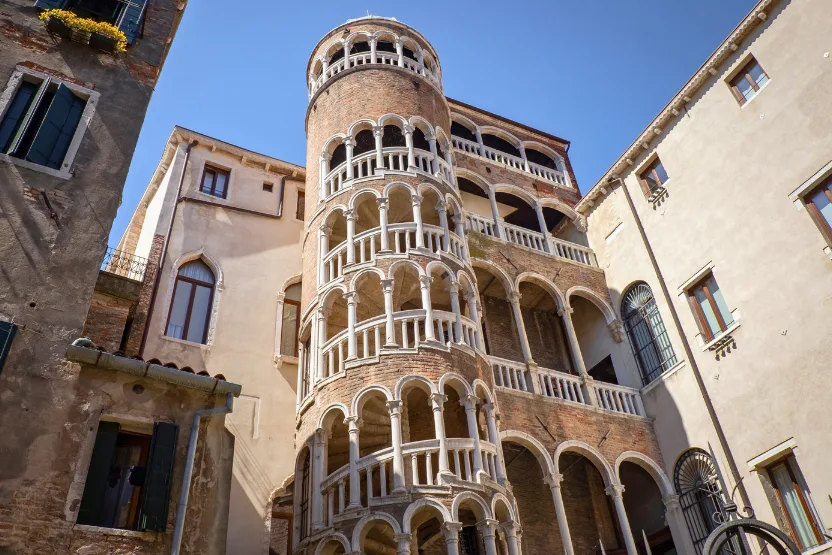
Palazzo Contarini del Bovolo. While it's a small palace, it's worth the visit for its unique spiral staircase. In fact, Orson Welles chose this location for his 1952 adaptation of Othello. The staircase is even open to the public!
Must-see bridges
You'll likely have a chance to see many bridges when you stay in Venice, but make sure you definitely see the following.

The Bridge of Sighs. Or, Ponte dei Sospiri in Italian. This arch bridge was built in the year 1600 and is made of white stone.

Ponte dell'Accademia. Located in Dorsodouro, this is one of the few bridges that cross the Grand Canal (the largest canal in Old Venice).
Ponte delle Guglie. Crossing over the Cannaregio Canal, this brick bridge dates back to the 1500s.

Ponte di Rialto. Or, Rialto Bridge in English. This is one of the most famous bridges in Venice and crosses over the Grand Canal. There's also a famous market nearby.
Must go-to places
St. Mark's Square. This is the large main square in Venice, called Piazza San Marco locally.
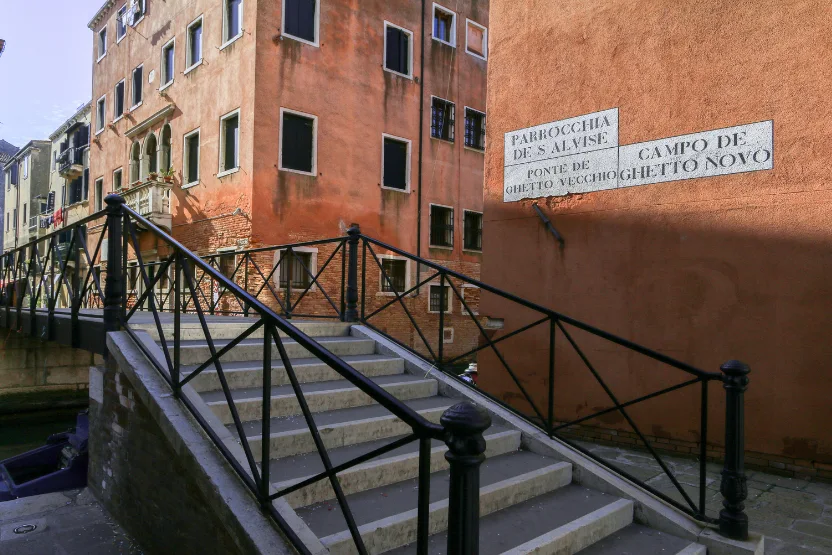
Campo di Ghetto Nuovo. Venice's Jewish community, located in the Cannaregio neighborhood.
Via Garibaldi. A small neighborhood in Old Venice with shops, parks, and more.
Fondaco dei Tedeschi View Terrace. This is the roof of a luxury mall, but it gives you incredible views over the Grand Canal.

St. Mark's Basilica. Located in the San Marco neighborhood, this famous cathedral has beautiful artwork, a museum, and even contains the bones of a saint.
Scuola San Rocco. This museum is often compared to the Sistine Chapel for its incredible ceiling paintings.
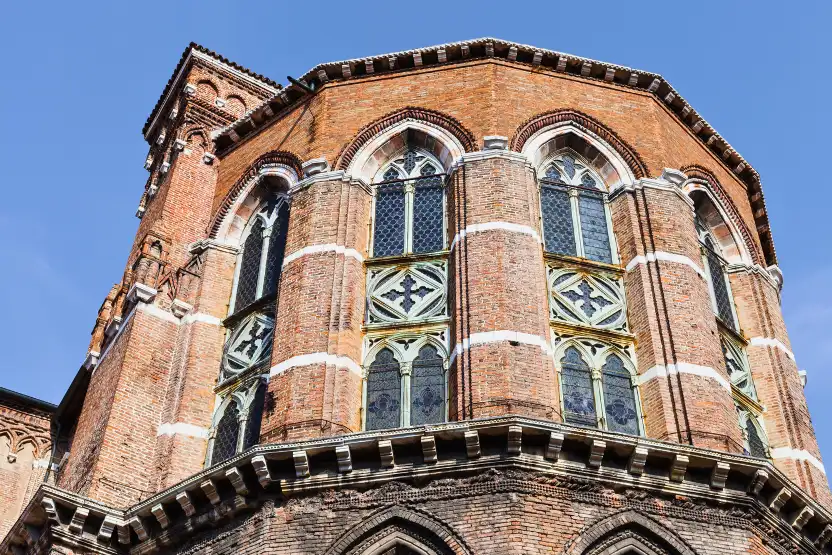
Frari Church. An ancient brick church that has art from the Renaissance masters. It is located in the San Polo district.
Unique things to do in Venice that are off the beaten path
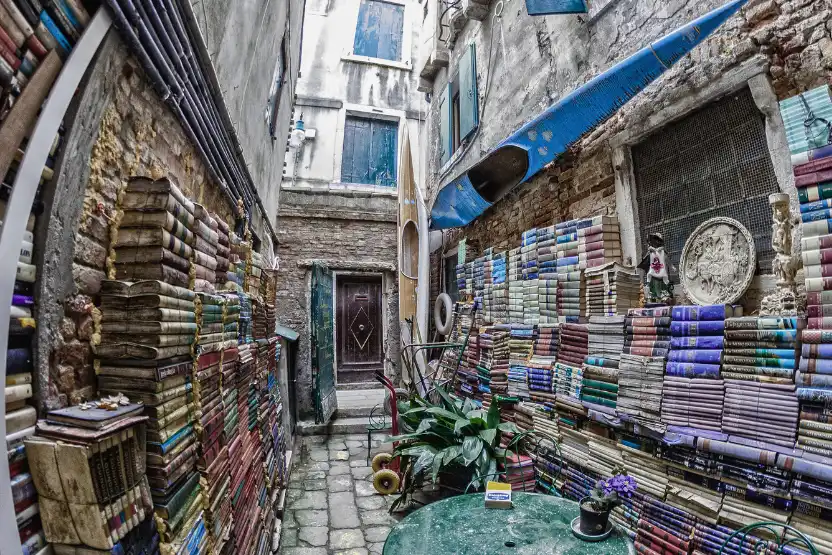
Visit a flooding bookstore
What: Libreria Acqua Alta
Where: The Cannaregio neighborhood
This bookstore occasionally floods, so its books are placed in interesting locations, such as bathtubs. Right off a canal, the narrow rooms of this bookstore offer a truly unique experience. Keep an eye out for some of the kitties that live there!
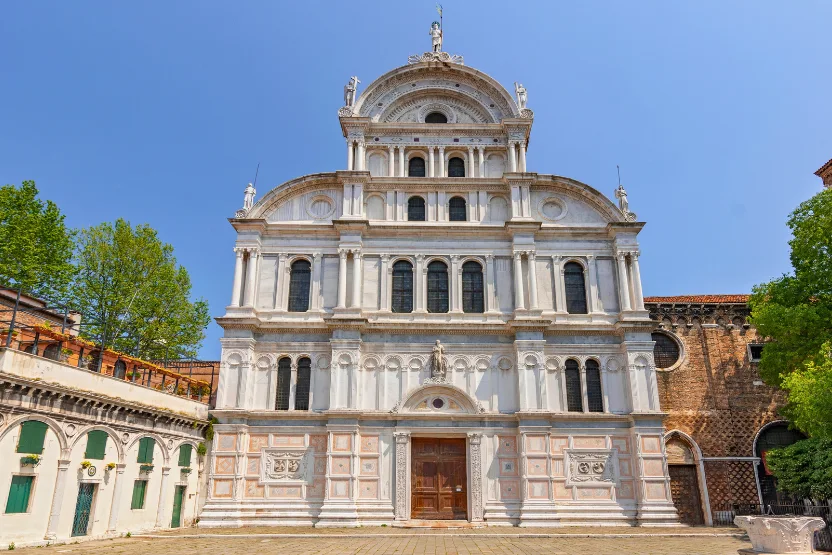
Explore a flooded crypt under a church
What: Chiesa di San Zaccaria
Where: Inside the chapel of St. Tarasius, in the Castello district
When the water levels are low enough, visitors to the church can pay a small fee to go underground and visit the flooded crypt.

See the cursed palace of Ca' Dario
What: Ca' Dario
Where: The Dorsodoura neighborhood
Ca' Dorio is a Gothic Palace in Venice that has quite the sordid history. Many of the people who have lived there over the centuries have met unfortunate fates. The building's facade is both beautiful and haunting. It's worth a stop, but best avoid setting up shop there... just in case.

Get educated about ancient medical procedures
What: Scuola Grande di San Marco
Where: The Castello district
Venice is home to a small medical museum that features old medical instruments, as well as old rare texts.
This museum is a bit hidden and costs a few euros to enter.
Be granted good luck at an old bridge
What: The Uncini della Fortuna
Where: On one end of the San Canciano Bridge
The "hooks of fortune" are hung on the corner of an old building at the San Canciano Bridge. Legend has it that touching these hooks before crossing the bridge will bring you good luck.

General tips for visiting Venice
Addresses work differently
The street is first and the number is second in Venice. So, instead of 123 Canal Way, the address would be Canal Way, 123.
Evenings are less crowded
Many tourists go to Venice for short day trips, making the daytime typically significantly more crowded than the evening. If you want to go to a popular tourist stop or landmark, it might be worth it to go in the evening to avoid the crowds (just make sure you look up what hours they're open).
Day trips will cost you, literally
To help reduce daytime crowds, Venice has established a "day trip" fee called an Access Fee. This fee is charged to tourists who are only visiting Venice for the day on specific days of the year. Tourists can expect to pay 5 or 10 euros per person, depending on how far in advance they pay the fee.
You might need a travel adapter
If you are bringing chargers and electronics (phones, laptops, etc.) from back home, you may need a travel adapter in order to use them in Italy. You can learn more about what is needed in our Italy Plug Type Guide.

Some travelers need visas to go to Venice
Some travelers need a visa to visit Italy (thus, Venice). We've written an entire guide about this topic that you can find here.
Get around on the water bus
Because Venice's streets are literally waterways, getting around any other way than on foot is a bit complicated. Venice has a public "water bus" called Vaporetto.
If you plan to hop on the Vaporetto more than once, it's likely more cost-effective to purchase a pass (such as for 24 hours, 48, etc.).
When you hop on and off, make sure you hold your ticket up to the little ticket scanner onboard in order to validate it. If you don't, you could end up paying a fine.
Avoid large suitcases if possible
Because of Venice's design (narrow walking area with bridges, stairs, and varying textures), getting around with a large suitcase can be a workout. If at all possible, try to avoid bringing large suitcases. We've put together a guide that is quite helpful when it comes to packing for a European holiday.
Related posts
Upcoming travels ? Get Insured !
Find the right insurance for your trip by using our powerful comparison tool!
Sarah Pardi - November 21, 2025
Sarah Pardi - November 20, 2025
Sarah Pardi - November 14, 2025
Sarah Pardi - November 13, 2025


